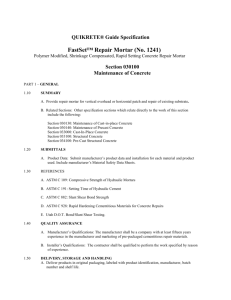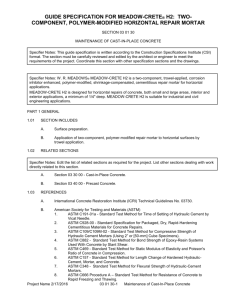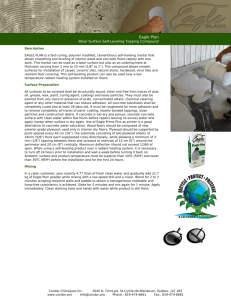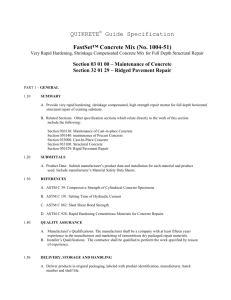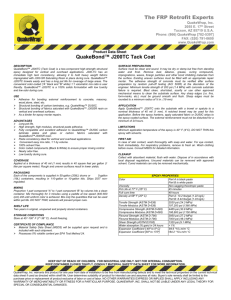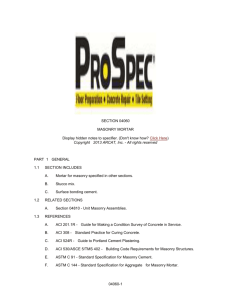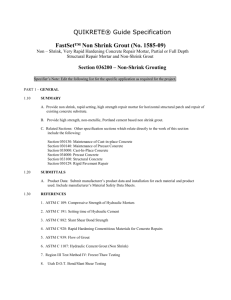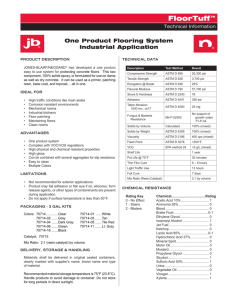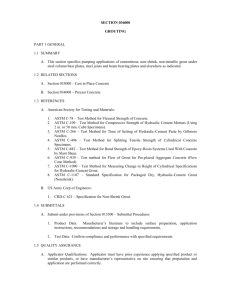H2 - US Spec
advertisement
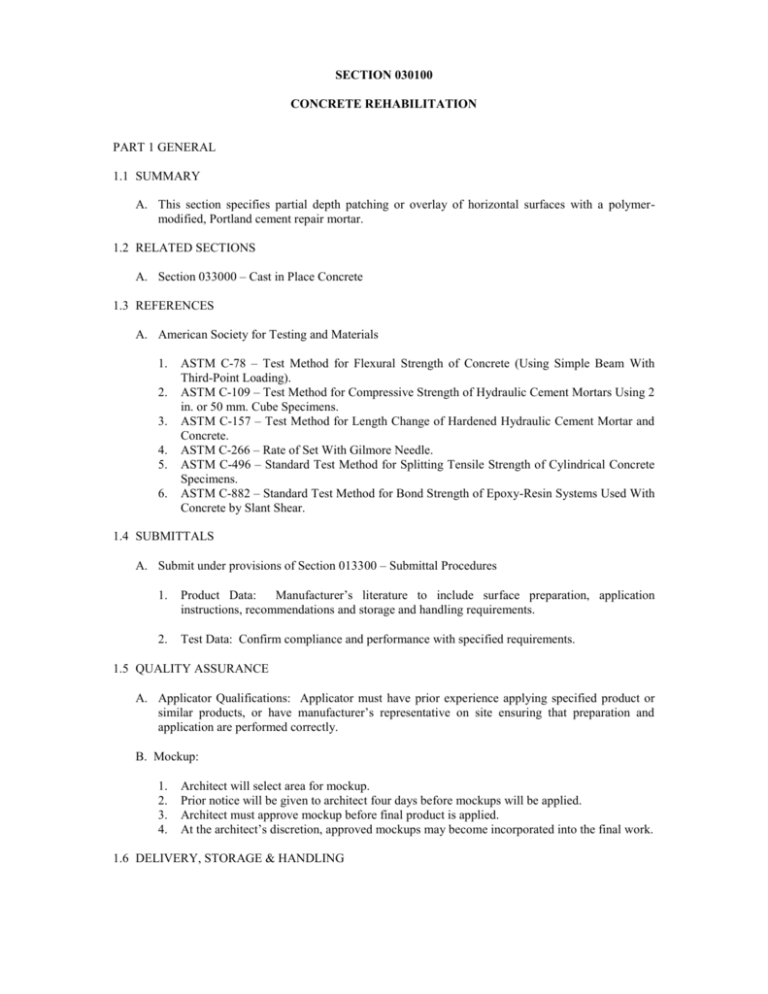
SECTION 030100 CONCRETE REHABILITATION PART 1 GENERAL 1.1 SUMMARY A. This section specifies partial depth patching or overlay of horizontal surfaces with a polymermodified, Portland cement repair mortar. 1.2 RELATED SECTIONS A. Section 033000 – Cast in Place Concrete 1.3 REFERENCES A. American Society for Testing and Materials 1. 2. 3. 4. 5. 6. ASTM C-78 – Test Method for Flexural Strength of Concrete (Using Simple Beam With Third-Point Loading). ASTM C-109 – Test Method for Compressive Strength of Hydraulic Cement Mortars Using 2 in. or 50 mm. Cube Specimens. ASTM C-157 – Test Method for Length Change of Hardened Hydraulic Cement Mortar and Concrete. ASTM C-266 – Rate of Set With Gilmore Needle. ASTM C-496 – Standard Test Method for Splitting Tensile Strength of Cylindrical Concrete Specimens. ASTM C-882 – Standard Test Method for Bond Strength of Epoxy-Resin Systems Used With Concrete by Slant Shear. 1.4 SUBMITTALS A. Submit under provisions of Section 013300 – Submittal Procedures 1. Product Data: Manufacturer’s literature to include surface preparation, application instructions, recommendations and storage and handling requirements. 2. Test Data: Confirm compliance and performance with specified requirements. 1.5 QUALITY ASSURANCE A. Applicator Qualifications: Applicator must have prior experience applying specified product or similar products, or have manufacturer’s representative on site ensuring that preparation and application are performed correctly. B. Mockup: 1. 2. 3. 4. Architect will select area for mockup. Prior notice will be given to architect four days before mockups will be applied. Architect must approve mockup before final product is applied. At the architect’s discretion, approved mockups may become incorporated into the final work. 1.6 DELIVERY, STORAGE & HANDLING A. Materials must be delivered in original, unopened containers with the manufacturer’s labels including product name and batch numbers. B. Store material in a dry area, above ground. Protect cement from moisture and humidity. 1.7 ENVIRONMENTAL REQUIREMENTS A. Environmental Conditions: Do not apply material when temperature is below 45°F (7 oC) or when temperature is expected to fall below 45°F within 48 hours. B. Protection: Precautions should be taken to avoid damage to any surface near the work zone. PART 2 PRODUCTS 2.1 MANUFACTURER A. Acceptable Manufacturer: US MIX Co., 112 South Santa Fe Drive, Denver, CO 80223, 800-3979903, http://www.usspec.com. 2.2 MATERIALS A. Cement-Based Repair Mortar: 1. 2. US SPEC H2 Description: Two component, liquid polymer modified, high strength, rapid hardening mortar for repairs up to 1” in depth. B. Liquid Polymer Bonding Agent: 1. 2. 3. US SPEC Acrylcoat Description: Acrylic latex, non-redispersable, liquid polymer bonding agent containing corrosion inhibitors. Corrosion inhibitor shall not be calcium nitrite. Minimum 25% solids content. Compliance: ASTM C-1059 Type II. C. Concrete Cleaner: 1. 2. US SPEC Maxi Concrete Cleaner Description: Citrus-based concrete cleaner to clean and strip dirt, grease and laitance from surfaces to receive patching compound. D. Membrane Forming Curing Compound: 1. 2. 3. US SPEC Maxcure Resin Clear Description: Dissipating hydrocarbon resin curing compound. Compliance: ASTM C-309 Type I, Class B. 2.3 MATERIAL PROPERTIES A. ASTM C-78 – Flexural Strength: 1. 2. 7 Days – 1,100 psi (7.6 MPa) minimum 28 Days – 1,800 psi (12.4 MPa) minimum B. ASTM C-109 – Compressive Strength: 1. 3 Hours – 2,700 psi (18.6 MPa) minimum 2. 3. 4. 1 Day – 4,000 psi (27.6 MPa) minimum 7 Days – 5,000 psi (34.4 MPa) minimum 28 Days – 6,000 psi (41.4 MPa) minimum C. ASTM C-157 – Length Change: 1. 28 Days – -0.06% maximum in air D. ASTM C-266 – Rate of Set: 1. 2. Initial Set – 30 minutes minimum Final Set – 45 minutes minimum, 1 hour maximum E. ASTM C-496 – Split Tensile Strength: 1. F. 28 Days – 1,400 psi (9.7 MPa) minimum ASTM C-882 – Bond Strength: 1. 7 Days – 1,000 psi (6.9 MPa) minimum PART 3 EXECUTION 3.1 EXAMINATION A. Examine areas to be repaired. Notify Engineer if surfaces are unacceptable. Do not begin surface preparation or application until unacceptable conditions are corrected. 3.2 SURFACE PREPARATION A. Areas to be repaired must be clean, sound, and free of dirt, oil, grease, laitance and other contaminants. Clean concrete with citrus-based concrete cleaner and stripper to remove grease. Dense, smooth surfaces shall be mechanically abraded, exposing a new aggregate surface. All loose and deteriorated concrete shall be removed. B. Substrate to receive patching mortar should be saturated surface dry (SSD) per ACI recommendations. C. Where reinforcing steel with active corrosion is encountered, sandblast the steel to a white metal finish, completely removing all contaminants and corrosion. Where corrosion has occurred due to the presence of chlorides, the steel shall be high pressure washed after mechanical cleaning. D. Areas that will endure heavy industrial traffic should be saw-cut and notched with a hand held chipping hammer. E. All control and expansion joints should be continued up through the repair mortar. 3.3 MIXING A. Mix in an appropriate sized mechanical mixer or mix in a bucket using a drill and paddle mixer at low speed (400-600 RPM). First, pour liquid polymer bonding agent into the mixing container. Then, add powder material while continuing to mix. Mix to a uniform consistency for a minimum of three minutes and a maximum of five minutes. B. Mix only the amount of material that can be placed within working time. Do not re-temper material. C. For placements greater than 1 inch in depth, extend material 30% by weight with clean, washed and dried 3/8 inch pea gravel (approximately 15 lbs. of gravel per 50 lbs. of dry mix). D. Do not blend in excess liquid. Do not use any other admixtures or additives. 3.4 APPLICATION A. Mortar must be placed immediately upon completion of mixing. B. Mortar must be scrubbed into substrate ensuring that all pores and voids are filled. While the scrub coat is still plastic, force material against edge of repair with steel trowel working away from the center of the repair. C. When material has reached proper set, shave, shape or mold with a steel trowel. 3.5 FINISHING A. Finish material with a broom finish or other desired finish. 3.6 CURING A. Cure freshly placed mortar with a liquid membrane forming curing compound. 3.7 PROTECTION A. Protect horizontal surfaces from traffic until repair mortar compound has cured. END OF SECTION
